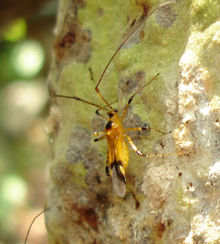Helopeltis
| Helopeltis | |
|---|---|

| |
| Helopeltis antonii | |
| Scientific classification | |
| Domain: | Eukaryota |
| Kingdom: | Animalia |
| Phylum: | Arthropoda |
| Class: | Insecta |
| Order: | Hemiptera |
| Suborder: | Heteroptera |
| Family: | Miridae |
| Tribe: | Dicyphini |
| Genus: | Helopeltis Signoret, 1858 |
| Species | |
The genus Helopeltis, also sometimes known as mosquito bugs, is a group of heteropterans in the family Miridae (capsid bugs) and tribe Dicyphini. They include pests of various crops, including cacao, cashew, cotton and tea. Now in a different subgenus, or placed in its own genus. A number of Afropeltis species are pests in Africa.
Mosquito bugs have a characteristic spine on the scutellum, which is a diagnostic feature.[1] Classification in the field is based on morphological characteristics, with considerable variations in colouration between insects of the same species (although for example, H. theivora is characteristically green and H. antonii red-brown).
Damage and distribution
With typical Hemipteran sucking mouthparts, they pierce plant tissues and cause damage ranging from leaf tattering and fruit blemishes, to complete death of shoots, branches or whole plants.
There has been evident speciation along the islands of the Malay Archipelago and there may be cryptic species in this genus. Helopeltis spp. sensu stricto are important 'new encounter' pests of SE Asian cocoa[2] including:
- H. antonii: India through to West Irian
- H. bakeri: Malay Peninsula and Philippines
- H. bradyi: Sri Lanka, Malaysia, Indonesia
- H. clavifer: Sabah and Papua New Guinea
- H. collaris: Philippines
- H. sulawesi: Sulawesi
- H. sumatranus: Sumatra
- H. theivora (with H. theobromae as a sub-species): India through to Java
Other cocoa Mirid pest species, very similar to Helopeltis, are the African species which were placed into Afropeltis by Schmitz (1968).[3] These species usually have a lesser pests status than their Asian counterparts, with Sahlbergella singularis and Distantiella theobromae causing greatest cocoa tree and crop damage in Central and West Africa. Monalonion species, belonging to the same tribe, are similarly minor pests of Latin American cocoa.
Species
The Catalogue of life currently (2023[4]) lists:
- Helopeltis alluaudi Reuter, 1905
- Helopeltis anacardii Miller, 1954
- Helopeltis antonii V. Signoret, 1858
- Helopeltis bakeri Poppius, 1915
- Helopeltis basilewskyi Schmitz, 1968
- Helopeltis bergevini Poppius, 1914
- Helopeltis bergrothi Reuter, 1892
- Helopeltis bradyi Waterhouse, 1886
- Helopeltis carayoni Schmitz, 1968
- Helopeltis cinchonae Mann, 1907
- Helopeltis clavifer (Walker, 1871)
- Helopeltis collaris Stal, 1871
- Helopeltis corbisieri Schmitz, 1968
- Helopeltis couturieri Schmitz, 1988
- Helopeltis cuneata Distant, 1903
- Helopeltis fasciaticollis Poppius, 1915
- Helopeltis gerini Carayon, 1949
- Helopeltis ghesquierei Schmitz, 1968
- Helopeltis hyalospilosus Schmitz, 1988
- Helopeltis insularis Kirkaldy, 1902
- Helopeltis labaumei Poppius, 1911
- Helopeltis lalandei Carayon, 1949
- Helopeltis lemosi Ghesquiere, 1922
- Helopeltis maynei Ghesquiere, 1922
- Helopeltis mayumbensis Ghesquiere, 1922
- Helopeltis melanescens Schmitz, 1988
- Helopeltis obscuratus Poppius, 1915
- Helopeltis orophila Ghesquiere, 1939
- Helopeltis pellucida Stal, 1871
- Helopeltis pernicialis Stonedahl et al.2, 1995
- Helopeltis plebejus Poppius, 1911
- Helopeltis podagricus (A. Costa, 1864)
- Helopeltis poppiusi Schmitz, 1968
- Helopeltis pseudomaynei Schmitz, 1968
- Helopeltis rauwolfiae Ghesquiere, 1948
- Helopeltis schoutedeni Reuter, 1906
- Helopeltis seredensis Schmitz, 1968
- Helopeltis sulawesi Stonedahl, 1991
- Helopeltis sumatranus Roepke, 1916
- Helopeltis theivora Waterhouse, 1886
- Helopeltis villiersi Delattre, 1947
- Helopeltis waterhousei Kirkaldy, 1902
- Helopeltis westwoodii (White, 1842)
Afropeltis
Entwistle (1972) lists and maps ten species of Afropeltis attacking cocoa:
- the A. bergrothi group:
- A. bergrothi: widely distributed east of the Niger River
- A. lalendei (= H. bergevini): very common, Ivory Coast to Nigeria
- A. serendensis: Ivory Coast and probably Ghana
- A. corbisieri: humid forest in central Africa
- A. gerini: southern Cameroun
- A. mayumbensis: north and east of the Congo River
- A. poppiusi: widespread, but only found on cocoa in Ivory Coast
- A. schoutedeni: the most widespread in tropical Africa
- A. lemosi: São Tomé and Príncipe
- A. westwoodi: widespread in west and central Africa
References
- ^ Stonedahl GM (1991) Oriental species of Helopeltis (Heteroptera: Miridae): a review of economic literature and guide to identification. Bulletin of Entomological Research 81: 465–490
- ^ Entwistle PF (1972) Pests of Cocoa, Longmans, London, 779 pp
- ^ Schmitz G (1968) 'Monographie des especes Africaines du genre Helopeltis Signoret (Heteroptera, Miridae) avec un exposedes problemes relatifes aux structures genitales', Ann. Mus. Roy. Afr. Cent. 168: 247 pp.
- ^ Catalogue of life (searched 20 December 2023)
External links
 Data related to Helopeltis at Wikispecies
Data related to Helopeltis at Wikispecies Media related to Helopeltis at Wikimedia Commons
Media related to Helopeltis at Wikimedia Commons- DropData cocoa pest guide
- PestInfo wiki